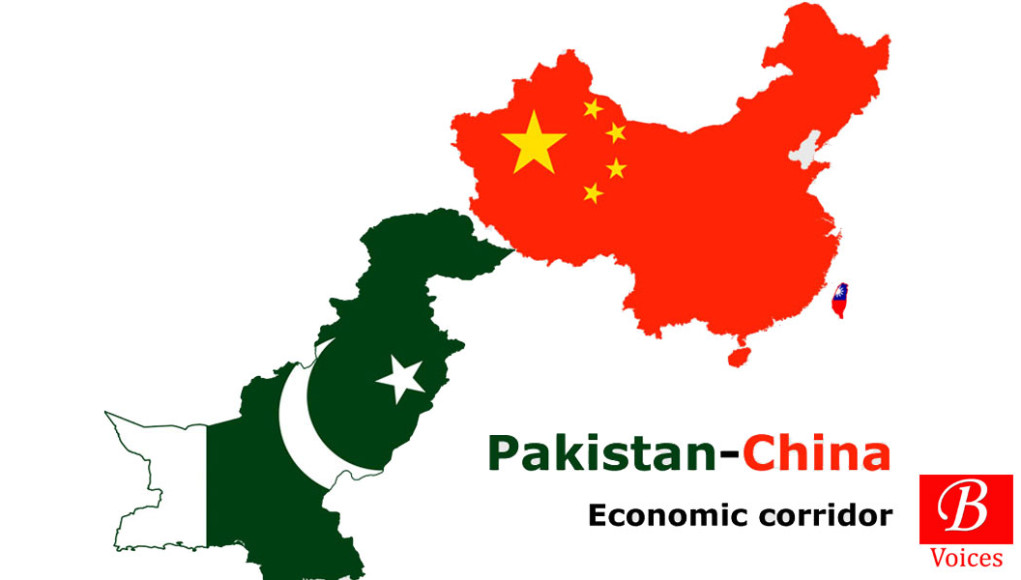Hira Hafeez
The China-Pakistan Economic Corridor (CPEC) is a deep-rooted tie between China and Pakistan. It is also a glaring and reflection of China-Pakistan friendship. The CPEC is an endorsement and continuation to the enhancing bilateral friendly relations between two countries. It is a commercial project and bilateral agreements which were signed between both China and Pakistan during the state visit of Chinese President Xi Jinping to Pakistan in April 2015. The CPEC is a mega project of 51 billion of US dollar of Chinese investment that incorporates infrastructure and energy projects. It has been said that the CPEC is a corridor of opportunity and in fact, it would also be a corridor of peace and prosperity among the regional powers too.
The term economic corridor was first used by Asian Development Bank in 1998 which defines it as important networks or connections between economic agents along a defined geography which links the supply and demand sides of markets. The Economic Corridors are the integrated transport networks of infrastructure within a geographical area which are designed to stimulate economic development. It facilitates not only the movement of goods and services. It also strengthens the exchange of information as well as people’s migration.
It provides important connections between economic nodes or hubs that are usually centered in urban landscapes. In real term, economic corridors are supposed to be functioned as a connector as well as purpose-built and to link connectivity, Logistic flows, production, development and commerce development and infrastructure within particular geographic structures. These physical infrastructures have to undertake a task of the center of economic activities.
On the one hand, an economic corridor has, as usual, an Urban-centered outlook and it benefits only to urban areas but on the other hand, it broadens benefits to rural areas as well through the development of transportation, inclusive development, broader economic policy and economic development as well as a connection for production activities.
In a long run, it paves the way for the financial integration, civilization integration, employment promoting, standardized trade facility and financial management. It also supports historical, social and economic complementariness and people to people cultural ties.
The CPEC project seeks to rapidly expand and upgrade infrastructure across the length and breadth of Pakistan as well as deepen and widen economic links with its ‘iron brother’ China. The CPEC is essentially a significant part of regional initiatives led by China known as the One Belt One Road (OBOR) economic development. The OBOR concepts consist of two ambitious development proposals. One arm is the land based known as New Silk Road Economic Belt (SREB) whereas another arm is the sea-based known as 21st Century Maritime Silk Road (CMSR).
Both China and Pakistan have agreed to build One Belt One Road project more commonly known as China-Pakistan Economic Corridor is expected to bring the new era of peace and prosperity in South Asian region. This corridor will incorporate 2,000-kilometer transport link between Kashgar in North-West China to Pakistan’s Gwadar port on the Arabian Sea near the border with Iran via roads, railways and pipelines.
There are many internal and external challenges for the Pakistani government to implement this multi-dollar project. However, it’s a game changer project which will transform the fate of Pakistan and will help to achieve economic gain. It will improve the economy and trade, enhances regional connectivity, develop infrastructure and establish people to people contacts on both sides.
The CPEC is the part of China’s vision One Belt One Road and this is the Southern corridor of Silk Road project. China is the new emerging power in the world. The importance of the CPEC is beyond the imagination.
Gwadar to Kashgar route will not only decrease the distance between China and Middle East but will also provide a safe and secure way of oil to China. Basically, the CPEC is the name of multiple roads of one corridor.
Moreover, the importance of this corridor is also reflected in the statement of Xi Jinping during his visit to Pakistan in 2015, he said that “this will be my first trip to Pakistan, but I feel as if I am going to visit the home of my own brother’ Moreover, it is a combination of cross-sectional components, infrastructure, trade connectivity, transport, energy services, industrial cooperation and so on.
However, regional connectivity and economic development are two major aspects of the CPEC project. It consists of roads, energy stations, rail routes and oil and gas pipelines.
Gwadar port is actually the tail of the Silk Road which will connect Kashgar through different communication networks. Gwadar holds a central place in the project of the CPEC. Gwadar could play a key role in ensuring China’s energy security. It has been said that Gwadar will also put China and Pakistan in a strategically advantageous position along the Arabian Sea.
The CPEC from all counts will prove a game changer and will make China a real stakeholder in Pakistan’s economy, stability and security. It promises to boost Pakistan’s economy and provide employment and business opportunities for local. Foreign investors can be attracted to invest along the long route of the corridor. The CPEC projects have huge significance, it runs through one of the most important and vital geo-strategic locations of South Asia. It connects the whole region and gives Pakistan central importance for world trade. It holds promise to make Pakistan an economic power in the world in near future.
The CPEC is the ‘game changer’ project. There are many challenges for Pakistan in implementing of this project. At the same time, Pakistan will have many benefits from this corridor. The new great game will increasingly revolve around China’s one belt one road vision of land and sea connections between Asia, Europe and beyond. The CPEC is the first component of this ambitious vision. The recent, inauguration of first CPEC consignment shipment from the Gwadar deep sea port is the beginning of the new era of the economic prosperity and progress for the region in general and for Pak-China long-lasting friendship cum partnership in particular.
Writer has completed her Master’s in Political Science from the University of Karachi and a CSS aspirant.
Disclaimer: Views expressed in this article are those of the author and Balochistan Voices not necessarily agrees with them.
Share your comments!








